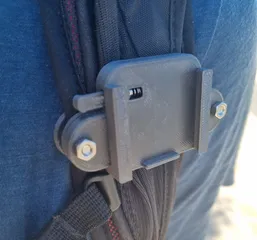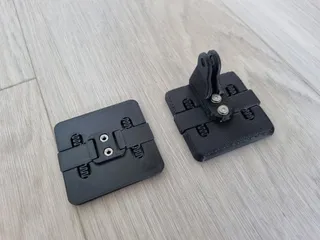Complete Solution for MK4/S MMU3 with Enclosure and AI Anomaly Detection
Description
PDFThis project provides a comprehensive solution for the MK4/S MMU3 in an enclosure. The setup has been thoroughly tested to ensure easy filament preparation, smooth SpoolJoin operation, and effortless removal of leftover filament. The design also facilitates simple removal of the printer from the enclosure for maintenance or upgrades. Additionally, the enclosure is used without the top lid, allowing the top surface to be utilized for filament spools, maximizing workspace efficiency.
Key Features:
Filament Handling: The system has been optimized for hassle-free filament management, including smooth filament loading and unloading.
For more reliable PTFE tube routing inside the enclosure, I used the included PTFE clip. The clip spacing is perfectly compatible with the Magnetic Quick Disconnect, keeping the PTFE tube securely in place and preventing unwanted movement during printing.
Tuya Indoor Air Quality Tester Integration: I’ve included a dedicated frame for the Tuya Indoor Air Quality Tester, securely mounted using a Thermometer bracket. This ensures that the air quality inside the enclosure is constantly monitored. It’s also useful for verifying the effectiveness of the HEPA filter, ensuring that air quality remains at safe levels during printing.
Corsair RS120 MAX Black fan: An important enhancement was the addition of active cooling, a critical factor in creating a stable environment within the enclosure. I installed a 120mm x 120mm x 30mm fan in the prepared spot in the upper left part of the enclosure. This fan plays a key role in stabilizing the internal temperature, effectively maintaining it below 30°C even when the room temperature is 24°C. Without this active cooling, the temperature inside the enclosure would rise to as high as 40°C, which negatively affected the quality of bridges when printing with PLA. The implementation of the fan ensures better printing results. To enhance efficiency, the ventilation is automatically activated via a remotely controlled socket, and the code for this functionality is a part of the attached GitHub project.
Beagle V2 Camera: To enable real-time monitoring and time-lapse capture of prints, the enclosure also includes a mounted Beagle V2 camera, providing photos to the Prusa Connect.
Hue Play Interior Lighting: The enclosure is equipped with interior lighting provided by a Hue Play light, which is mounted at the top front section of the frame. This placement ensures optimal illumination of the print area, enhancing visibility during operation and monitoring. Additionally, the Hue Play light allows for remote control, enabling convenient adjustments to the lighting settings as needed. The light can be easily mounted using a single screw without any modifications.
xLCD External Placement: A key improvement is the placement of the xLCD on the top external side of the enclosure. This provides much easier access to the display, eliminating the need to open the enclosure for printer or MMU3 operation. This design not only improves usability but also helps maintain consistent temperature and air quality inside the enclosure during operation.
You will need those cables for this modification:
- https://www.prusa3d.com/cs/produkt/lcd-kabel-xl/
- https://www.prusa3d.com/cs/produkt/xlcd-pe-kabel/
- and 25 pin D-Sub connector
Noise Reduction: To minimize noise during printing, I added an "Anti-vibration Pad for 3D Printers 50 x 50 x 0.8 cm" underneath the printer inside the enclosure. This pad effectively reduces vibrations and dampens noise, enhancing the overall printing experience. The pad can be purchased from MaterialPro3D.
Printer Removal
The printer can be removed from the enclosure through the standard door, with a modification using the PSU Cable Quick-release for Original Prusa Enclosure (MK4/S). Before removing the printer, it is necessary to detach the MMU3 unit from the printer's frame. Since the MMU3 unit remains connected to the printer by a cable, it is recommended to place it on the provided accessory called the MMU3 Takeout Holder. This positions the MMU3 unit lower, allowing the printer to be easily removed from the enclosure. Additionally, the display cable must be disconnected (25 pin D-Sub connector). As the display is mounted outside the enclosure at its top, the printer is smaller without it, making removal significantly easier. It’s also essential to disconnect the Magnetic Quick Disconnect for MMU PTFE Tubes. Both the Beagle V2 Camera and the Tuya Indoor Air Quality Tester Integration can remain inside the enclosure during this process.
Big Thanks!
To complete this project, I utilized all the models listed below. A big thanks to the creators for their amazing work!
Magnetic Quick Disconnect for MMU PTFE Tubes
https://www.printables.com/model/627113-magnetic-quick-disconnect-for-mmu-ptfe-tubes
Loading aid for the MMU3 buffer segment R3
https://www.printables.com/model/953671-loading-aid-for-the-mmu3-buffer-segment-r4
- with this small improvement https://www.printables.com/model/1133918-enhanced-buffer-lid-autofeeder
MMU3 buffer enclosure mount
https://www.printables.com/model/888562-mmu3-buffer-enclosure-mount
MMU3 PTFE Tube Guide - Remix
https://www.printables.com/model/922208-mmu3-ptfe-tube-guide-remix
PTFE Passthrough for Original Prusa Enclosure MMU2 MMU3
https://www.printables.com/model/515697-ptfe-passthrough-for-original-prusa-enclosure-mmu2
Beagle Camera v2 Mount for the Prusa Enclosure
https://www.printables.com/model/614134-beagle-camera-v2-mount-for-the-prusa-enclosure-fre
MMU3 Ultimate Spool Holder
https://www.printables.com/model/645773-mmu3-ultimate-spool-holder
xLCD enclosure top mount
https://www.printables.com/model/823562-xlcd-enclosure-top-mount
3D Printer Monitor with AI Anomaly Detection
A camera inside the enclosure transmits images to Prusa Connect. Leveraging OpenAI to analyze the most recent three images, the system detects potential print errors in real time. When an error is detected, the script triggers various IFTTT actions—such as pausing the print and automatically activating enclosure ventilation for PLA and PETG. Primarily, this script serves as an illustrative example of how to send camera images and process them using machine learning. Written in Python.
https://github.com/nickelsound/3DprinterMonitor/
Recommendations
- For printing PLA with MMU3 in the enclosure, I’ve found that a nozzle temperature of 205°C works best. At higher temperatures, filament jams occurred in the extruder during unloading.
- For TPU printing, simply remove the PTFE tube from the Nextruder, feed the filament through the top of the enclosure, and print completely outside the MMU3 unit.
- For printing filaments other than PLA or PETG, just use the single extruder profile without MMU3 in the slicer. The printer will ask which spool to use, and although the print will still go through the MMU3, the unit itself will not engage.
- Before starting a demanding MMU print with many color changes, it’s a good idea to check the tightness of the side screws on the Nextruder, which hold the brass nozzle in place. Frequent filament changes can put strain on the vertical movement of the nozzle, potentially causing it to loosen and shift during the print.
Tags
Model origin
The author marked this model as their own original creation.




